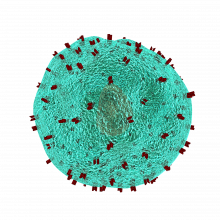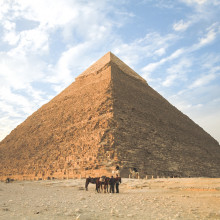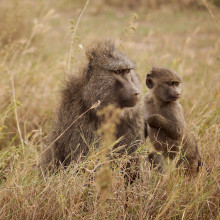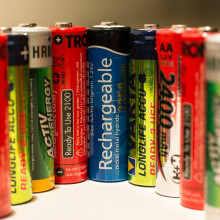Ancient Egyptian Mysteries
This week, solving the mysteries of ancient Egypt: we delve into the discovery of secret chambers hidden inside pyramids, and if glowing bones reveal antibiotic use was going on thousands of years ago… Plus, in the news, the fireball that shot across the UK night sky; a new device protects women from HIV; and the carbon footprint of cultivating cannabis...
In this episode

00:59 - Fireball meteorite found in British driveway
Fireball meteorite found in British driveway
Mary McIntyre, UK Meteor Observation Network
On the final day of February, people in some parts of the UK were treated to a celestial light show as a meteor streaked in from space. Hundreds of videos of the fireball have since been posted online by amateur photographers. What’s even more special is that by analysing the footage caught on multiple networks of cameras, for the first time in three decades in the UK, the culprit - and as it turns out very rare - space rock was successfully tracked down and recovered from someone’s driveway! Phil Sansom spoke to the UK Meteor Observation Network’s Mary McIntyre to hear how it happened...
Mary - There was a really bright fireball picked up across multiple networks a week ago on Sunday. And later in the week, we found out that a meteorite had in fact been recovered. And this is an incredibly rare thing to happen in the UK, actually even in the world, to recover a meteorite that's been seen as a fireball is quite rare. Then we found out that it's one of an extremely rare kind of meteorite. So just so many special things. And we've all just haven't been able to sleep because we were just so excited and such a huge win for citizen science. It really was.
Phil - Wow. And you didn't even know it was coming, did you? It just sort of appeared as a flash, right?
Mary - Yeah. These things, you can't predict them. They're entirely random pieces of space debris. And this one was really unusual because it was captured by so many cameras across the UK because we had a clear sky across the country.
Phil - What does it look like? Is it just a bright - the whole sky lights up? Or is there like an angle that you can see? And that's how you figure out where it's going.
Mary - It depends where you see it from. So our camera, so it was heading straight for us. So actually on our camera, there was just an enormous flash and it was really difficult to get any data from it because you couldn't see a flight path. But there's a guy called Richard Fleet down in Wiltshire who caught it side on. And it is the most phenomenal kind of bright thing streaking across the sky that just resulted in this enormous kind of explosion. And it fragmented. We could see that there were multiple fragments there. And once you kind of do the calculations behind the scenes, they can figure out the speeds it was moving [at], the angle through the atmosphere, its exact path before it burned up. And once you do all of that, then you can also figure out the mass. And once you know the mass, you can then calculate whether something may have survived and landed.
Normally something like that would be kind of kept quiet for fear of contamination, but because of Covid and the fact that the area that they think it landed in was basically lots of farmland in the Cotswolds, none of us actually thought for a second that this would get recovered. And if it was recovered, not for many days when it had been rained on and all of that stuff. So it was, it was just incredible.
Phil - It could have gone in a stream, I'm guessing? It could have gone in, I dunno, a sheep's trough and sheep ate it.
Mary - Well, many fireballs in the UK are thought to survive but they end up in the sea, because the UK is quite a small island.
Phil - So who actually found it and how?
Mary - One of the homeowners had actually heard a thud on their drive the previous night, rather than the house. And they just didn't think anything of it. But once the Natural History Museum put out a video to locals saying, "if you see anything, please have a look". And they went out and there was a fragment and some dust and kind of black rays on their driveway. And I think a fragment bounced over the wall to next door's garden. Once people arrived on the scene from Wednesday onwards, there was like a fingertip search of the area and more fragments have been found. And we've now found about 400 grams of this, which is just extraordinary.
Mary - You said that not only was it amazing space rock, it's also a very special kind of space rock?
Mary - It is. It's a type of meteorite called a carbonaceous chondrite. And they're really important because most of them originate from the asteroid belt. And I mean, asteroids themselves are really old because they're leftover material from when the solar system formed 4.5 billion years ago. But what's amazing about carbonaceous chondrites is they have these tiny little spheres of material that actually predates our solar system. Some of them have organic materials like amino acids in them. And to get a sample that is really pristine like this is incredibly rare, and so important for scientists to kind of analyse the material and find out the origins of our solar system. And before our solar system! It's just been one of the most amazing stories of the decade. And there hasn't been a fall that's been found for 30 years in the UK. So, wow. It's amazing.
Phil - And what's funny as well is - aren't there missions going on right now, sending probes up to asteroids way out in space, desperate to try to get any sort of sample from them? And we've just had one land right at our doorstep!
Mary - It is. Well, there was actually a mission to the asteroid Ryugu. And the quality of this sample is comparable with that sample return mission from Ryugu. And they brought back like tiny amounts of the asteroid. And we've now got 400 grams of this! I mean, you can't rely on them landing as a way of analysing them because it just doesn't happen very often. Meteorites are found all the time, but they've been led on the ground for who knows how long. And I just, I still can't quite believe it's real. I just, honestly, when I found out I just cried because it's such an amazing story. Astronomy gets me like that.

06:33 - HIV prevention in women using a wearable ring
HIV prevention in women using a wearable ring
Albert Liu, San Francisco Department of Public Health
Around the world, close to 40 million people are living with HIV, most of them in poorer countries. But in recent years there have been encouraging results from a drug-impregnated ring that's inserted into the female genital tract, showing that it can cut HIV infection rates by 50%. It's made of a soft silicon material, and a new version of the device that has recently been designed and tested for safety can remain in place for up to 90 days at a time, where it steadily releases a cargo of the anti-AIDS drug dapivirine. It could make a big difference to the autonomy of women in poorer countries, which have been hard hit by HIV in the past few decades. Public health researcher Albert Liu has just presented the latest performance and safety results at a conference, as he told Chris Smith...
Correction: The original publication of this interview indicated that the 90-day ring cuts infection rates by 50% - this is still unknown, the monthly ring has been shown to cut infection rates by 50%. This recent study tested pharmacology and safety exclusively.
Albert - Women make up more than half of all people living with HIV and they need a range of strategies to prevent HIV infections. One promising approach to HIV prevention is the use of vaginal rings, which are really exciting because they offer a long acting prevention approach to preventing HIV.
Chris - Now, when you said that women make up more than half of cases, why are they disproportionately impacted by HIV then?
Albert - In Sub-Saharan Africa, it may be unequal relationships with men, as well as some women engage in sex work and may have less economic opportunities. And there may also be some biological differences that make women more susceptible to HIV.
Chris - And the approach that you're testing here - tell us how it actually works then. What does it do? And how does it protect the user?
Albert - The vaginal ring that we have been studying was developed by a non-profit group, the International Partnership for Microbicides. They've developed a ring that contains a medication called dapivirine. It's an anti-HIV medication that is dispersed into the ring and releases the drug slowly into the vagina. This medication prevents infection taking place in the body.
Chris - And does it actually work? Is that what you're finding?
Albert - There were two large studies in over 4,500 women in Africa and they found that the ring was both safe and effective in reducing HIV infections. The latest studies that were done suggest that the ring reduced HIV infections by about 50%.
Chris - Why is this better though than just popping a pill? Because we could give this same drug in pill form, which arguably might be even easier to distribute.
Albert - Yeah. The pill form of prevention also known as PREP or pre-exposure prophylaxis is a really important and exciting option for HIV prevention. But what we've seen across a number of studies is that oral PREP is not for everyone. There may be a number of reasons why women may prefer not to take a daily pill. It can be challenging for people to remember to take the pill every day. Also the pills need to be kept private and that can sometimes be a challenge. So there needs to be a range of options for women to be able to choose different options that will work the best for them.
Chris - And is the strategy then that the women insert these rings and keep them inside for the full lifetime of that ring, or do they take it in and put it out on a daily basis? How does it work?
Albert - The ring is designed to be inserted and remain in place for the duration of use. And so for the monthly ring that's for a whole monthly period.
Chris - You've got a ring here which has got just one drug in it. Is that not a risk though that we're going to end up with the next scourge of HIV being resistant to that drug? And it will just therefore surmount the protection conferred by these rings, and people are going to catch HIV anyway?
Albert - That was looked at in several of the earlier studies, they looked at women who became HIV positive in the studies, and they did not see development of HIV resistance as a result of use of the ring.
Chris - How is this going down with the users?
Albert - Women have reported that the ring is very easy to use and also neither they nor their partners could feel the ring during sex. And they liked this option as a prevention strategy.
Chris - And impact on fertility? Is there any impact on likelihood of conception? Are these drugs considered completely safe if a person does fall pregnant while they are using this particular method?
Albert - There isn't evidence that these rings affect fertility. We are currently doing a study of ring use during pregnancy and it's a really important study because women during pregnancy are particularly vulnerable to acquiring HIV.

12:14 - Tetraquarks: new configurations of subatomic particles discovered
Tetraquarks: new configurations of subatomic particles discovered
Harry Cliff, University of Cambridge
Researchers using the Large Hadron Collider at CERN say they’ve recently discovered a new exotic form of subatomic particles called tetraquarks. They exist for just fractions of a second, so they’re hard to spot and study. But, luckily, University of Cambridge physicist Harry Cliff, is working on the experiment that discovered them, as he described to Chris Smith...
Harry - Very simply a tetraquark is a particle made of two quarks and two antiquarks. So, sort of four objects inside it basically, hence the tetra. It probably requires a bit of unpacking though, because well, you might ask what's a quark? Well, every atom has a nucleus, and you probably know that the nucleus is made of protons and neutrons. And we've known for more than half a century now, that protons and neutrons are made of three quarks each, bound together. Until recently we only knew of combinations of quarks that came in threes, or in pairs. So tetraquarks are a whole new class of particle that we didn't know about until relatively recently.
Chris - It's funny, isn't it? Because the reason we call atoms atoms, is the Greek word tomos means cut. And atomos means can't be cut down further. So initially scientists thought atoms were the smallest possible things. And then people realised that atoms have got things inside them, protons and neutrons, and thought they were the smallest things. And then people like you started smashing things together at very high energies and realised that those tiny things inside atoms, have actually got tiny things inside those. Those are the quarks.
Harry - Yeah, that's exactly right. And there was this big mystery in the 1940s and 1950s, when in particle colliders and in astrophysics experiments, people were discovering all these new subatomic particles, with all strange names. They're all usually, with Greek letters, like omegas and deltas and lambdas, and it was called the Particle Zoo. No one really understood what these particles were, and it was eventually realised you could explain this huge number of different particles, as being combinations of basically six different types of even smaller particles called quarks. So that's our most up-to-date understanding of the basic ingredients of matter today.
Chris - Why don't these things hang around for very long though?
Harry - Basically it's to do with the forces that bind them together. So actually there's only one particle made of quarks, as far as we know, that's completely stable and that's the proton. So that's the thing that's inside every atom. And that is a good thing that the proton's stable because if it wasn't, well, you know, every atom would disintegrate. But anything apart from the proton basically is unstable. It can always collapse, and it can either sort of break apart, or annihilate with itself and turn into other particles. So these things, because they're bound together, but not in a way that allows them to exist for any length of time. And they very quickly disintegrate into other sets of particles, which we then detect in our experiments.
Chris - Are they therefore a real and important part of physics? Or do you think they're just an artifact of the fact that you have, in an unnatural way, slammed particles together? You can detect these things transiently, but because they disappear, they play no part in genuine physics, or do you think they really do have a role to play in the way that the universe works?
Harry - Well, they tell us something about one of the four forces of nature. So we know about four forces, gravity, the electromagnetic force, something called the weak force, and the strong force. And the strong force is the force that holds the nucleus together, holds quarks together. But the strong force is really mysterious. Despite being, you know, a force we've known about for ages. It's really hard to understand, and it's very hard to make predictions using our theory of the strong force. So we can't really work out in advance, how quarks come together, and what combinations are allowed and which ones aren't allowed. So discovering new particles like these tetraquarks tells us something about the way this strong force interacts, and as one of the four basic forces in nature, that's a really important thing to get a deeper understanding of, and has impacts on the rest of our understanding of particle physics as well.

15:58 - Cannabis production: the carbon footprint of new industry
Cannabis production: the carbon footprint of new industry
Hailey Summers, Colorado State University
Although the use, sale, and possession of cannabis is still illegal in the USA at a countrywide level, in 2012 the states of Colorado and Washington became the first to legalise it for recreational use. By the end of last year, 12 more states had followed suit, and 36 states have legalised it for medicinal purposes. This has taken what was an underground blackmarket of cannabis production into the mainstream, with legal cannabis sales projected to reach 22 billion dollars by next year. But cultivating cannabis on this scale is very energy intensive: the plants are grown indoors under powerful lights and with additional CO2 pumped in to maximise the yields. And this got Colorado State University researcher Hailey Summers wondering about the carbon footprint of all this “home grown” produce, as she told Eva Higginbotham...
Hailey - It's a windowless warehouse, the smell hits you right away, and there's just a canopy of green. And then you've got these really high intensity lights that almost feel like you're getting a sunburn inside. And then there's a suite of dehumidifiers around the room, and there's usually simple office fans mounted to the walls that are circulating air. And then there's a number of climate control systems on the wall because most growers really care about the environment that these plants are being grown in, and so they control it heavily to make the best product possible. In our study, the primary intent was to quantify the greenhouse gas emissions from growing cannabis plants indoors.
Eva - Why would someone choose to grow cannabis indoors, where they have to provide things like light, as opposed to growing it outdoors, when the sun's just there?
Hailey - Yeah, there's a number of reasons. A big one is being able to control the product. When you grow artificially indoors, you can keep your indoor climate, your temperature and your humidity, very regulated, and that allows you to make the best product possible. There's also some security or theft issues, an indoor warehouse is a very secure environment. Also it allows you to get multiple harvests per year because you can create an artificial environment and grow year round, you're not limited to just the weather outside, right? If we were to grow cannabis outdoors in Colorado, for example, purely outdoors, we would probably only be able to achieve one harvest per year, whereas indoors, you can get about six harvests per year.
Eva - What kind of factors did you have to consider?
Hailey - So we investigated two primary inputs, and that would be your energy inputs and then any material inputs needed. The energy inputs primarily break down to either electricity or natural gas, and then the material inputs we considered include things like water or fertilisers or carbon dioxide. And so we looked at basically all of the quantities of those inputs needed, and then we equated those inputs to greenhouse gas emissions using a standard methodology called life cycle assessment.
Eva - And what did you find?
Hailey - The total amount of greenhouse gas emissions was pretty significant. So we analysed over a thousand locations across the US and we accounted for variations in weather and electric grid mix., and so those play a pretty big role in determining your overall greenhouse gas emissions. In Colorado, we were able to obtain the amount of cannabis being produced, and that translates to about 1.7% of Colorado's annual greenhouse gas emissions.
Eva - How big of an impact is this intensive growing of cannabis having in comparison to other industries that we know release a lot of greenhouse gases too?
Hailey - In the past few years a previous study came out and said that about 4% of Denver's electricity is coming straight from these growth facilities. So that's a pretty big portion of our electricity use. And to put this into context, there's a couple other sectors that I can compare that to. One would be coal mining operations, those in the state of Colorado are about 1.5% of the state's annual total., so a little bit less.
Eva - If we just switched to renewable energy resources, which is hopefully on the horizon in lots of parts of the world coming up, would we solve the problem of this energy intensive farming?
Hailey - I think that growing indoors in the state that we are is probably the worst it will be. As we clean up the grid, it's certainly going to help, but there's still some of these material inputs such as the carbon dioxide supply that are not directly associated with the grid.
Eva - If it's so hard to grow cannabis in Colorado, where it is cold, why don't we just grow it all outside in California, where the weather is ideal for growing cannabis?
Hailey - So there's a couple of reasons why we can't do that in the current state. and the biggest one is legalisation. So currently for states that are either medically or recreationally legalised, you would have to grow that cannabis in the state that it's legal in. So right now we can't grow in a state and then transport across state lines. If federal legislation was to lift, we could probably come up with a centralised location to grow the majority of cannabis and then distribute from there.

21:26 - Interactive evolution: simulating an ecosystem
Interactive evolution: simulating an ecosystem
Tom Johnson, Slug Disco
A new video game simulation is being published by a company called Slug Disco. It models the evolution of life in a realistic underwater world. You put basic starting creatures into the water, and then create the environment in which they will live. You then watch as they evolve and adapt to their environment, and to each other, just as Darwin described. It’s called Ecosystem, and the Naked Gaming Podcast’s Chris Berrow caught up with its creator, Tom Johnson...
Tom - It's kind of inspired by some research that was done in the nineties at MIT, by a guy named Karl Sims, and he was working with virtual evolution. So the idea is that you have these creatures that are actually a bunch of boxes joined together, basically. And they have virtual brains that are basically pipeline computers. So they take in visual input, auditory input, stuff like that. They do a bunch of processes. And then as an output, they apply torques at all their various joints. So they kind of move around just like we do. So unlike a normal game, the creatures aren't necessarily playing like an animation that an artist made, they're actually contracting joints at each joint that they have. And so the idea is that if you take a bunch of these creatures, just like totally random ones, with random brains and random bodies, and you throw them in the ocean, most of them will just kind of flail around, right. They'll just be moving their hands and arms, or their limbs, and not going anywhere, but a few will probably get a little bit. And if you let the ones that move the furthest have the most children, then after enough generations, you will actually have creatures that can actually swim. So in that sense, it's like a true evolution game, because the physiology is driven by the function. And so the premise of the game is basically that you shaped this environment and then, you sort of throw in these creatures and they adapt to all the different niches that you create
Chris B - How do you model something like that? Because I know that there are existing models for evolution, but how did you actually design that into a game context? Because that strikes me as probably the most difficult thing.
Tom - Yeah. It took a lot of work. And in fact, when I first started, it would actually take a full day just to get an evolution, just to get a creature that can kind of swim. It was a very sort of experimental process, because it doesn't map quite cleanly to an existing game. There's not some well-established tradition that I could kind of follow in, and copy, you know? So to some extent there's a big element of creativity to it, that you kind of have this fish tank, except that the fish are morphing to your tank.
Chris B - What are some of the other factors that are at play here?
Tom - There's a couple of other ones. One that I did recently was a creature vision system. So in addition to their physical body shape, their skin colouration and pattern, and stuff like that also evolves. And it's sort of encoded in their DNA. And so when creatures are preying on each other, they have a vision simulation. So in order to actually see a creature, if it's green against the green background, it's harder to make that out. Like the better it fits to that, the harder that creature is to see, because for example, a bunch of foragers that have no predators anywhere don't actually really need camouflage. And so they may end up more like the, you know, the birds of paradise, right? Like the classic ones with the incredibly ornate, because it's better for mating, right? If you have the best shiniest, whereas if there's a bunch of huge sharks swimming around looking for you, then suddenly you don't want to be the most ornate, beautiful purple fish, but you want to be the one that looks just like the dirt.
Chris B - I'm presuming that if you were to in real life, create an environment, that exactly the same thing wouldn't happen every time. Like, you know, you might suddenly find that actually, you know, some creatures with shiny wings or whatever would start to become very prominent. But then if you ran it again in real life, you might find that actually camouflage became the way to go just for no reason, just because that's sometimes what happens with evolution. Does that happen in the game as well? Or is it very much if you were to chuck the same thing in the same environment, it happens the same way.
Tom - There's quite a bit of variation, just because of random features and even how creatures are reacting as part of their environment is the other creatures, in a sense. There's a decent chance, at least if you set the pressures just right, that you could probably get a camouflage to statistically occur more frequently. One of the main goals for the game was that I wanted to sort of make sure that it could actually reproduce, as much as I could, the amount of variety that you see in life. So I think I would have been a little disappointed if like, you always got the same handful of things. And for that reason, they often tend to come out looking like little monsters. You get a lot of very alien looking things. But there's probably a decent chance that if you threw some microbes into the ocean and Earth, you may not necessarily get fish again. You know, you might not get things that look exactly like the fish that we're used to.

25:56 - Mailbox: T cells, B cells, on the sea shore...
Mailbox: T cells, B cells, on the sea shore...
Time for our mailbox - and this week we’ve had this poetic question from listener Zo ‘B cells, T cells, she sells, sea shells - please explain what these cells do, are they equally important?"
Chris - Thank you Zo, well, obviously this is a question that's very pertinent at the moment, we're hearing a lot about the immune system, because of headlines around coronavirus. To put it simply, these are both types of white blood cell that are important components of your immune system. B cells make antibodies, or are involved in the production of antibodies, which are sticky molecules that go around in the bloodstream and can mop up things that shouldn't be there. And they take a while to make once you've seen a threat for the first time, and they can protect you should you re-encounter that threat into the future. T cells are a different kind of white blood cell, and they are actually in a number of categories. One are called helper cells, and they actually help to boost the response of other parts of the immune system. There are also a very important class of T cells called cytotoxic T cells, and they're programmed to go and inspect all the cells in the body as they drift around in the bloodstream, and find out what those cells are doing, and if there's signs that they are harbouring a virus or producing viruses, they can nuke the cells and destroy them. So together, these things are your adaptive immune system: B cells make antibodies, which can defend you against encountering a threat again in the future; and T-cells can help the immune system to do what it does, and also get rid of cells that are harbouring viruses right now.

28:51 - Unpicking the timeline of ancient Egyptian pharaohs
Unpicking the timeline of ancient Egyptian pharaohs
Tom Higham, University of Oxford
The first of the mysteries we’re going to look at are the pharaohs - the Kings and Queens of Egypt. We have reasonably good chronological records for the later periods of ancient Egypt, but, as you go back further, the records get more murky. This is made worse by the fact that new pharaohs had a habit of making their mark by demolishing the paintings and monuments of their predecessors. Tom Higham is an archaeological scientist at the University of Oxford and author of the new book ‘The World Before Us: How Science is Revealing a New Story of Our Human Origins’. He’s been involved in a project to figure this out...
Tom - Yes, absolutely. What we see quite often is that new pharaohs came to power by virtue of plotting or coups, and they overthrew their predecessors. And once they'd done that, in an attempt to establish their own legitimacy, they would go back and rub out evidence for their predecessors in the form of temple inscriptions, papyri, and so on. And in fact we see this to this day: Hosni Mubarak's image - and that of his wife - was systematically removed by court order in Cairo following the Arab spring. So it's something that we see again and again.
Chris - And this presumably creates something of a puzzle, because although they wrote things down and we knew who lived when in relation to whom, if we haven't got physical things to tether to particular eras or people, it makes actually understanding that timeline that much more difficult!
Tom - Indeed. And this is part of the problem. I mean, we often think about ancient Egyptian chronologies as being absolutely precise and robust. But as you say, there are gaps in the record, and there are periods where pharaohs tried to rewrite history for themselves and eliminate the evidence for other people. And when you visit Egypt and you see the walls of temples and so on, you can see where, often, there has been destruction, and people have subsequently pecked out evidence for cartouches identifying different rulers and pharaohs. So as you go back in time, we have problems identifying precisely who ruled when, and for how long.
Chris - How are you trying to get underneath this then, and basically write history the right way, rather than the wrong way that people have sought to manipulate the record?
Tom - One thing that we can do is we can use radiocarbon dating. And radiocarbon is a method that was developed in the late 1940s, so it's a long established tool, and it basically revolves around the fact that all of the carbon that we and all living organisms uptake has a tiny proportion of radioactive carbon, or carbon-14. And this radioactive carbon is constantly replenished until death. When an organism dies, the amount of radiocarbon slowly begins to degrade away and disappear. And what we know is the rate at which that disappearance occurs: we know that every five and a half thousand years, half of the amount of radiocarbon disappears. And so by measuring the remaining radiocarbon in an archaeological bone or piece of wood, we can get a date for it.
Chris - But people must've done that; given this technique is coming up for its hundredth birthday, as you're saying, they must've already done that with all the artefacts we have from ancient Egypt.
Tom - Yeah, they did. But what we found was that there was a sort of mistrust of radiocarbon methods, because it hadn't properly been applied in the past. Instead, people had just dated anything really; they dated old pieces of charcoal and wood from temple complexes, which often predated the use of that wood in those complexes of temples, and graves, and so on. And this is a really key point in radiocarbon: we have to select good material that date as closely as we can to the date of the archaeological event we seek to understand.
Chris - I see. So if, for instance, I wanted to know how old my wheelbarrow was, but I inherited it from my granddad, I would get a false date because it's not a new wheelbarrow. Whereas if you go for something which can't be inherited, or can't be recycled, as it were, you potentially have got a much more fine grained - if you'll excuse the pun, because I was thinking of things like cereal grains and things...
Tom - Absolutely. So what we did was we went back to these burial contexts that contained independent historical evidence from the Egyptian chronology. So for example, we found evidence in the form of inscriptions on the side of the grave, in which that person died during the seventh year of the reign of King Joseph, for example. And then in that grave, we would find short-lived pieces of grain, and floral wreaths in the form of funerary materials, and so on. Those are the things we focused on dating in order to kind of crack the problem of when these things happen in the past.
Chris - That would give you a nice, neat timeline for that murky period back in history. When you assembled that timeline, did you then discover that in fact, things that we thought we understood well were in fact wrong, and we had it wrong all along?
Tom - We didn't find that in the recent period, because of the fact that we have a pretty good understanding of that historical record. So we didn't find major differences there; in fact, that was one of the things that gave us confidence that we were getting things right. But as we moved back through time, back through the Middle Kingdom and especially into the Old Kingdom, we found that our date estimates were much earlier than we thought previously. And they were about a century earlier than previous estimates had put forward. So that was quite an important conclusion to reach. Also, we found that the period before the domestic periods - the period of the Egyptian state and its formation - we found that this happened much more quickly than had happened in similar cases of state formation in places like the Middle East and Africa. And so that was also a very interesting thing, because it showed that the Egyptian state began very quickly, from pastoralists and people that were moving around the landscape, from a period where they then started to grow crops and to be more sedentary, and live in the same place. And shortly after that, state formation happened and we get pharaohs, we get institutions, we get writing, and so on and so forth.

34:17 - Secret chamber found in ancient pyramid: the Big Void and beyond
Secret chamber found in ancient pyramid: the Big Void and beyond
Sébastien Procureur, Atomic Energy and Alternative Energies Commission
Arguably one of the most iconic legacies of ancient Egypt are the pyramids, which were built as tombs for pharaohs and other high-ranking officials and hundreds still stand, thousands of years later. Explorers have found their way inside many of them and uncovered rich archaeological treasure troves within. But could the ancient Egyptians have craftily concealed more inside their pyramids than we realise? At 140 metres high and 230 metres long, one of the largest pyramids has been well explored and studied, and the chambers inside have been thoroughly mapped. Or so we thought. Because now, using radiation streaming in from space to see through the pyramid, researchers have found something very exciting, as Eva Higginbotham heard from physicist Sébastien Procureur...
Eva - The Great Pyramid of Giza is thought to be the tomb of one of the earliest pharaohs of Egypt, King Khufu. More than 4,000 years after its construction, it's still receiving visitors.
Sébastien - It smells of dust, essentially. Surprisingly it's quite humid because there are many tourists visiting the place. There are even mice actually; we had some issues with the telescopes because mice were visiting them and eating some cables. There is some life inside!
Eva - That's Sébastien Procureur. He's a chief physicist on a project called Scan Pyramids. Launched in 2015, Scan Pyramids is a collaboration between institutions in Egypt, France, and Japan, all trying to gain a deeper understanding of the Great Pyramid.
Sébastien - The idea was to check the internal structure of a pyramid. We've done CT measurements with the idea to check whether there is any room, cavity, hole, corridor, or whatever, which could be inside the pyramid but which we've still not found.
Eva - Inside the pyramid, there are three main chambers that we know about: the King's Chamber, the Queen's Chamber, and an underground chamber that appears unfinished. There's also a 47 metre long corridor leading to the King's Chamber called the Grand Gallery. To investigate whether there were any other chambers inside the pyramid, the Scan Pyramids team used an imaging technique called 'cosmic muography'.
Sébastien - In photography you use a photon, which is light, to make an image of an object; but of course you have only the external image of the subject, you don't see inside. Muography, on the other hand, uses muon particles, and the advantage is that it can really see the inside of a structure.
Eva - It works by the detection of muons - elemental particles produced by the interaction between the atmosphere and other particles called cosmic rays. The muons make it down to earth and are highly penetrating. They can go through tens or hundreds of metres of solid rock, depending on their energy. Scientists can use the variable penetration of muons to figure out the density of a structure. It's like a race. At the start of a race you know how many people are taking part, and by looking at how many people make it to the finish line...
Sébastien - ...and just making a ratio of these two numbers, you have an estimate of the difficulty of the race. With muons it's exactly the same, that is, some of them muons will cross the whole pyramid, but some others will stop, just because they didn't have enough energy to cross the whole pyramid. So just by counting the number of muons crossing the pyramid in a given direction, you have an estimate of the difficulty of the race - that is, an estimate of thickness, and then the density.
Eva - The teams set up muon detectors inside and outside the pyramid at different locations. And by taking what are essentially cosmic muon photographs at different angles, they built up a picture of what the internal structure is like, including where some conspicuously empty areas were in what should have been solid rock.
Sébastien - With the muography measurements we were able to find three different cavities. The first cavity was found on the northeast edge; then a second cavity was found just on the north face, just behind what we call the chevron zone.
Sébastien - And the third cavity, which is the biggest, we've found above the Grand Gallery so it was called the Big Void. The length is estimated to be about 30 metres - between 30 and 40 metres long. So it's several hundreds of cubic metres in total
Eva - Sébastien and the team are confident that what they found is not just a deformation in the rock, or smaller stones that have crumbled, due to the careful way that they imaged the pyramid from multiple locations. They used simulations to help guide where they should put the detectors.
Sébastien - And it turned out that the position that the simulation gave us the best position was the - let's call it the restroom of the camels!. So we had to discuss with the camels...
Eva - And there's other evidence that what they found is a real secret chamber
Sébastien - What is also very intriguing and cannot be considered as a coincidence is that all of the structures I was talking about, so all the rooms and corridors, they are placed in the same plane in the pyramid. So it's a North-South plane, which is slightly shifted with respect to its centre, so of the plane is seven metres in the East direction. And it turns out that this Big Void is also placed in this special plane. So all this says that it cannot be a coincidence and there is really a big, significant void at this place.
Eva - I asked Sébastien if he thought there might be something inside the Big Void
Sébastien - If there is a tomb, if there is some object of any kind, even gold or whatever, I mean, we can imagine whatever! And actually there are already several theories of what this void can be. One theory is that it may be the real tomb of a pharaoh. Another theory is that it was used as a storage place. There's an interesting theory also which says it might be a second Grand Gallery. And in this theory actually the Grand Gallery was used to put the granite stones of the King's Chamber. Maybe a second Grand Gallery was required to put the highest stone of the King's Chamber.
Eva - It may be that the Big Void was created as a necessary part of the construction of the pyramid, and Sébastien is confident that future scans, with even newer techniques, will help reveal more details of how this great pyramid was built. Also, one of the long standing curiosities of Khufu's pyramid is that, unlike most other pyramids which are richly decorated with images and inscriptions, telling stories about the life of the person buried there, there is virtually nothing on the walls of Khufu's pyramid. On top of that, it's completely empty of the objects we know people were often buried with - things like pottery and gold that they would need in the afterlife. This is no surprise, really, as tomb robbery was absolutely rampant in ancient times, but still - perhaps the Big Void, and the other spaces they found, represent untouched, undisturbed chambers, which themselves could hold the key to understanding more about the mysterious Khufu's reign.

41:36 - Locating the ancient lost city of Punt with mummified baboons
Locating the ancient lost city of Punt with mummified baboons
Nathaniel Dominy, Dartmouth College
One of the mysteries concerns a long lost city, called Punt, which was hugely significant as a trading partner of the ancient Egyptian civilisation. Unfortunately, while they wrote a lot about Punt, the Egyptians didn’t say exactly where it was, so archaeologists have hit a dead end trying to understand how that ancient trade operated. Now, that might be about to change thanks to a breakthrough involving animals that the Egyptians kept as pets and went to Punt specially to purchase - baboons! They also mummified them, meaning specimens of those pet baboons exist in museums and, critically, still carry a chemical fingerprint of where they came from originally, putting Dartmouth College’s Nate Dominy on the scent of where Punt might have been, as he told Chris Smith..
Nate - There are two mysteries, a mystery wrapped in a mystery. And the first involves baboons because baboons have a very large distribution across Subsaharan Africa. And generally across Africa, baboons are disliked. You rarely see baboons in any kind of statuary or carving or any kind of handicraft. Egypt, however, is the big exception because when you look at the entire arc of Egyptian history, you see that baboons have been revered, they've even been deified. They've been elevated into the Pantheon of Egyptian gods. So it's really quite a striking reversal to the general patterns across Subsaharan Africa. The puzzle for someone like me, who studies primates, is that baboons never lived in Egypt. The Holocene fossil record, which is the period of time of modern human habitation and agriculture and complex societies, is entirely devoid of any evidence of any primate whatsoever - let alone baboons.
Chris - Have we got physical specimens of baboons from that geography nevertheless? They must have encountered them because they defied them.
Nate - That's right. So we find baboons buried in human contexts. They were deliberately buried. The oldest evidence looks like it might've been a zoo. One young baboons is buried with a young person about age 12 or 13, suggesting status as a pet. And then at later periods, we get Royal mummification where the animals were actually wrapped in linens and interred in Royal tombs in the Valley of the Kings. And then in a still later period, during the Roman and Greek period, we get the period of animal cults where baboons and many other animals were mummified on a practically industrial scale. You get tens of thousands of animals being mummified during that period.
Chris - So therefore if you've got evidence of these animals being deified in that particular geography, you've got evidence of specimens of them being brought to that geography, but there's no evidence that they were naturally there, this argues that any baboons that are there were brought there by human activity and therefore the question must be from where?
Nate - Precisely. And the Egyptians, they have written records of importing baboons into Egypt. They have paintings and reliefs on their temple walls and tombs showing the importation of baboons from a distant place. And they tell us that place - the place was Punt. And that's the other mystery is, where was Punt?
Chris - So there's lots of references to a place, but that place no longer exists, and we don't know where it is?
Nate - Right. Historians have argued about Punt because it was terribly important because the Egyptians, typically when they wanted resources, they might go to war to get those resources. We know the Egyptians went to war with the Nubians, they went to war with the Hittites. But with the Puntites, they sent emissaries, they sent ambassadors, they sent diplomats. This was a very important trading partner for the ancient Egyptians, primarily because the Puntites produced very valuable incense that the Egyptians used for religious purposes. So the Egyptians were highly motivated to travel great distances to go to Punt for these exotic luxury goods, including baboons.
Chris - So how can you use our knowledge of baboons to work out where Punt is then?
Nate - Baboons are a really great animal system for this question because baboons drink water every day. And the water in your environment reflects the rainfall, and the chemical composition of water evaporates at different rates. And so when animals are drinking water on the landscape, they incorporate those chemical signatures, the oxygen stable isotopes in the water, and that incorporates into their bones and in their teeth and in their hair. And so you get this geographic fingerprint of where an animal has been living based on the kind of water and food it's been ingesting.
Chris - But what about if you do what you said, which is that there's evidence that there were animals being held in captivity in Egypt, will you not then see the signature of Egypt rather than the signature of where the animal came from written into those ratios?
Nate - Yes, that was a great risk of the project, that long-term captivity would produce a geographic signature associated with living in captivity in Egypt. And so we use different tissues, hair, bone teeth, which integrate drinking water and food over different intervals of the animal's life, and a large number of animals. For example, the baboons that we studied that were at the Petrie Museum in London, those animals uniformly showed us a signature that was consistent with a lifetime living in Egypt. And so we think the Egyptians may have had a husbandry program, they may have been breeding them in captivity. But we got very lucky - there was one animal at the British Museum that showed us a signature in the teeth that showed a distinctly foreign signature. It was unambiguously non-Egyptian.
Chris - So in order to work out where Punt must have been, are you reasoning then that if you triangulate the origins as written down in the teeth and other specimens of these baboons, that Punt must be somewhere relatively equidistant from these places, or close to where a lot of these animals were originating from, that that would give you a narrowed geography for where Punt was likely to be?
Nate - Exactly. So the Egyptians tell us that Punt was East and South of Egypt, and they tell us that you could reach it by land or sea. Problem is that East and South of Egypt - still a lot of open possibilities! And so what we can do is we can take baboons living in all of those competing areas - Somalia, Eritrea, Ethiopia, Yemen, Sudan, Uganda - we can take that baboons living in those areas now, and we can look at their chemical signatures and create a chemical map, if you will, of that region. And so then we can match the mummified specimens that are present at the British Museum to populations in those areas. And the great thing about our analysis is we could definitively rule out some places, and we showed a very strong match to animals living in Eritrea and Somalia today.
Chris - That would be, therefore, the most likely place where the animals were sourced from, but do not just think that it could just be that was a good hunting ground, and they were transported from there to wherever Punt was?
Nate - That's right. Punt was both a kingdom and an emporium on the coast. So there was a market town or port. And so we think the Egyptians would have pulled their ships up to the port and they may have purchased or traded for animals that were there in the port city. But the animals may have been sourced from farther inland, and that makes sense. We think the Puntites knew their market, they knew their consumers. And so they would have gathered animals from farther inland and brought them for trade with the Egyptians.
Chris - So how much narrower is the search for Punt now in the wake of what you've done?
Nate - Much narrower. For 150 years, scholars have been debating about the possibility of the Arabian peninsula. So Yemen has always been a strong contender for the location of Punt. Some authors have put it in Mozambique or Uganda. We can rule those places out. And we can say definitively that it was somewhere in Africa, on the horn of Africa, probably in Eritrea and Somalia. We can't distinguish between those two places, which are the two contending places that most scholars agree on.
Chris - And is there any way to nail it well and truly?
Nate - Yes, I think so. I think if we can turn to ancient DNA, maybe turn to some of the other tissues that were coming out of Punt, if they all start to point in the same place and corroborate each other, then we'll really have something. And obviously archeology is where we need to go. It'd be nice to dig in some of those areas. And if we can find the remains of these ancient places that'd be the clincher.

49:56 - Antibiotics in ancient bones: tetracycline and glowing human remains
Antibiotics in ancient bones: tetracycline and glowing human remains
Tamsin O'Connell, University of Cambridge
South of ancient Egypt was a land called Nubia, and archaeologists have made a surprising finding there too: signs that the Nubians were being exposed to antibiotics! Human bones recovered from the area glow green under UV light which is due to tetracycline, an antibiotic we use today, embedded in the bone. The University of Cambridge’s Tamsin O’Connell is an archaeological scientist, and she spoke with Eva Higginbotham to explain the story...
Tamsin - They were getting it from things that they were eating or drinking, and we think it's an accidental product that gets in there. So if they're consuming something like beer or bread made from grain that might have tetracycline in it, then that gets incorporated into their bones. And a long time later, we get to see it glowing under UV light.
Eva - Why might there be tetracycline in grains?
Tamsin - Tetracycline is a naturally occurring product of fungi, and it occurs naturally when fungi grow under certain conditions. And that can be when grain is stored in slightly damp environments. So if they're having a wheat harvest and then putting it in a big grain storage area and you have water that's kind of coming up and going down in the ground, then that could make the green at the bottom go slightly mouldy. It would still be good enough to eat, but it might contain kind of trace levels of tetracycline.
Eva - I see so if they then use that wheat to make beer or bread, then they're going to be accidentally eating tetracycline. So then how does the tetracycline get from being eaten as bread to being incorporated into bone?
Tamsin - So tetracycline, it's quite a big molecule and it's got a ring structure in it of carbon chains, and its structure loves to bond to calcium, and there's a lot of calcium in your bones. And so as bones are growing, as this calcium phosphate, which is in your bones, is being laid down, if there's something in your bloodstream that likes to bond to it, then it will just be kind of stuck in there and it will hang around forever.
Eva - So does that mean that if you've ever taken tetracycline, then you have some glowing bones?
Tamsin - Yes, pretty well. So the bits of your bones that were being remade, remodelled, turned over, when you were taking tetracycline or any similar sort of antibiotic, that includes things like doxycycline which is an anti-malarial, those bits of your bones will glow if you could get them out and look at them under UV light.
Eva - So maybe try to avoid that for now then! How do we know though that the tetracycline got into the bone because it was incorporated by the bone owner throughout their lifetime, rather than it got into the bone through some sort of contamination? Because it has been thousands of years.
Tamsin - That is a really good question. And whenever we find anything in archaeological samples, we have to question whether or not it's naturally occurring, if it came in during the individual's lifetime, or if it came in later on. And the shape of the glowing lines within the bones tells us that it looks like it's sort of on the growing face of a bone cell being formed rather than percolating in from contamination later on.
Eva - I see. So it's sort of just in the right place to mean, all right, this got in there because it was being incorporated officially as part of bone rather than randomly slapped on afterwards?
Tamsin - Yes. It's worth saying that tetracycline is used as a label in modern day studies of bone turnover and bone remodelling, so we know an awful lot about what it should look like when it's being taken up by living and growing bone. And so comparing the archaeological bones and the patterning, what we see there, with what we know we see in modern bones when tetracycline is being used as a bone label, gives us confidence that it is being laid down when these people were alive.
Eva - And do you think that it could have had some sort of health benefits? Is there enough tetracycline in there that it could have had a benefit to the person consuming it?
Tamsin - Having low grade antibiotics in your diet could have some benefit if people were having bacterial infections. But we really can't say that they knew that it was of health benefit to them. Although we do know from the texts that beer dregs are often included as an ingredient in medical prescriptions from a roundabout this time - 4,000 years ago. And so it's possible that they knew that there were some good things that they were accidentally getting in beer and bread.
Eva - So do we have any other evidence of ancient Egyptians or other civilisations taking antibiotics possibly on purpose?
Tamsin - Not that they're taking it on purpose, but we can see tetracycline in bones from other populations. So it's been found in people who were living in Herculaneum at the time of the eruption of Vesuvius. I would speculate that any population where grain has been stored and could have got mouldy, we'd be able to see some tetracycline in there

54:56 - QotW: What's the difference between batteries?
QotW: What's the difference between batteries?
Listener Michael got in touch to ask "Why can't batteries, such as AA or AAA size, be recharged? What's the difference between regular batteries and rechargeables, especially lithium ones? Is this a 'big battery' conspiracy to sell more batteries, or are there valid reasons?"
Katie - A big battery conspiracy huh? Well here are 3 scientists who can route out this recharging riddle: Gareth Hinds from the National Physical Laboratory, and David Hall and Didi Rinkel from Cambridge University.
Gareth - There are two types of battery – primary cells, which are designed for single use, and secondary cells, which are rechargeable.
David - Every single battery in the world consists of a positive electrode, a negative electrode, and some sort of electrolyte solution – that is a salt dissolved in a solvent.
Gareth - When a battery is discharged, electrochemical reactions occur at each electrode, converting chemical reactants to products and generating electricity.
David - However, there are many choices for the electrodes and for the salts and solvents. Only some of these can be recharged, which scientists call “secondary cells” – but for others, like most AA and AAA batteries, using the stored energy is a one-way street.
Didi - Whether a battery is rechargeable or not depends on what the positive and negative electrodes are made of. The most common AA and AAA batteries are called alkaline batteries, and these have zinc metal and manganese dioxide electrodes. When you use the battery, the zinc metal is eaten up and you form zinc oxide. Unfortunately this reaction is irreversible, which means that you cannot get the zinc metal back if you recharge the battery.
Gareth - In a secondary cell the electrochemical reactions are reversible. For example, in a Li-ion battery the very small Li-ions can easily insert into both electrode materials - usually graphite and a mixed metal oxide - so the electrochemical reactions work equally well in both directions. This means that the battery can be charged and discharged many times; usually for thousands of cycles.
Didi - There are also rechargeable AA or AAA batteries, such as the nickel metal hydride battery. The reactions in this type of battery are reversible which means that you can recharge the battery and use it again.
Gareth - So this is not a conspiracy by battery manufacturers – primary cells are inherently limited to a single discharge, while secondary cells are not.
David - Ultimately, when choosing a battery to use, one has to consider the energy needs of the device. For example, a cordless drill needs lots of power in short bursts, which takes a higher voltage battery. But a smoke detector uses very small amounts of energy over a long period of time, and so needs low-voltage batteries, such as your standard double or triple As.
Katie - I just need to remember to check which batteries are the rechargeable ones before I put them in the charging station! Thanks Gareth, Didi and David. From batteries to boredom, because next time we’re boring into this question from Douglas…
Douglas - Do animals get bored eating the same thing all the time? Like sheep, do they get bored of one type of grass?
Related Content
- Previous Reflecting on Corruption
- Next Developer Special: Slug Disco










Comments
Add a comment